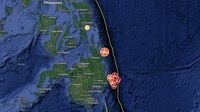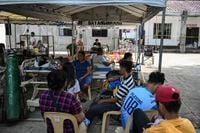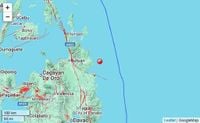On the night of October 11, 2025, the southern Philippines was rocked by a magnitude 6.0 earthquake, the latest in a series of powerful tremors that have rattled the region in recent days. According to the United States Geological Survey (USGS), the quake struck just off the coast near Aras-asan in Mindanao at 14:32 UTC (22:32 local time), at a depth of approximately 59 kilometers (36.8 miles). The epicenter was pinpointed 10 kilometers east-northeast of Aras-asan, about 28 kilometers southeast of Tandag, and within 94 kilometers east of Butuan, in the Caraga region.
The Philippine Institute of Volcanology and Seismology (PHIVOLCS) also recorded a closely timed magnitude 6.2 earthquake centered 22 kilometers northeast of Cagwait in Surigao del Sur, at a shallower depth of 10 kilometers. Both agencies reported that the tremors were felt widely across Mindanao and neighboring provinces. Residents in Davao City, Cagwait, and Carmen experienced Intensity IV shaking, while Intensity III was reported in Bislig and Mati, among other areas. Instrumental readings confirmed the quake’s reach, with Intensity IV recorded in Cabadbaran City, Nabunturan, Hinunangan, and Tandag City, and Intensity III in a host of other municipalities, stretching from Bukidnon to Southern Leyte and Misamis Oriental.
Despite the strength of the quake, there were no immediate reports of casualties or significant structural damage. Arnel Besinga, a fire officer in Cagwait, told AFP, "The duration of the quake was not that long, just around 30 seconds, but it was so sudden and so strong. Our pots here in the fire station fell in our kitchen." He added that a joint assessment of the extent of the damage was underway, but the darkness hampered immediate evaluation. "We cannot say the extent of the damage at this point, if there are any, because it's already night and it's dark here," Besinga explained.
While the USGS issued a Green alert for shaking-related fatalities and economic losses, indicating a low likelihood of casualties and damage, the psychological impact on residents was palpable. The USGS estimated that about 231,000 people felt moderate shaking, 4,146,000 experienced light shaking, and more than 6.3 million felt weak tremors. The region’s population lives in a mix of vulnerable and earthquake-resistant structures, with some buildings more susceptible to seismic activity than others. Fortunately, there was no tsunami threat from this earthquake, and the USGS noted that landslides and liquefaction were not expected to pose significant risks.
This latest quake is believed to be part of an ongoing aftershock sequence following the powerful magnitude 7.4 earthquake that struck off eastern Mindanao on October 10, 2025. That earlier event, which occurred near Manay town in Davao Oriental province, was among the most powerful to hit the southern Philippines in recent years. According to reports from The Watchers and Associated Press, the main shock, followed closely by a magnitude 6.7 to 6.8 aftershock, caused widespread devastation—at least nine people were killed and more than 900 injured. Tsunami warnings were briefly issued for parts of Davao Oriental, Surigao del Sur, and neighboring coastal provinces, prompting evacuations. Thankfully, these warnings were lifted after no significant waves were detected.
The October 10 earthquake’s toll was grim: deaths included two hospital patients who suffered fatal heart attacks during the quake, a resident in Mati city struck by debris, three villagers killed in a landslide in Pantukan town, and another resident in Davao City. Hundreds more were injured, many in Davao City itself. The Office of Civil Defence reported that several buildings, including the city’s international airport, sustained cracks, though flight operations continued uninterrupted. Schools across the region were evacuated, with about 50 students hospitalized for injuries ranging from bruises to fainting and dizziness. In Governor Generoso, a town about 100 kilometers south of Manay, disaster-mitigation officer Jun Saavedra described the chaos: "I was driving my car when it suddenly swayed, and I saw power lines swaying wildly. People darted out of houses and buildings as the ground shook and electricity came off."
President Ferdinand Marcos Jr. responded swiftly, stating that the government was assessing damage and preparing rescue and relief operations. Emergency teams were deployed to the hardest-hit communities, focusing on search and rescue efforts and restoring essential services. Power interruptions and communication disruptions were reported in parts of Mindanao, complicating coordination among first responders. Structural damage ranged from cracked walls and collapsed facades to damaged bridges, with residential homes, public buildings, schools, and hospitals among the most affected.
The Philippines’ vulnerability to seismic disasters is a product of its location on the Pacific "Ring of Fire," an arc of intense seismic and volcanic activity stretching from Japan through Southeast Asia and across the Pacific basin. Earthquakes are a near-daily occurrence, and the archipelago’s history is punctuated by devastating events. The deadliest on record remains the 1976 Mindanao quake, which unleashed a tsunami that left 8,000 people dead or missing. More recently, a magnitude 6.9 earthquake struck Cebu province in late September 2025, killing more than 75 people and injuring over 1,200.
As rescue and assessment operations continue, authorities are bracing for possible further aftershocks. PHIVOLCS chief Teresito Bacolcol explained that the October 10 doublet quakes—two significant tremors occurring close together in time and space—were both caused by movement along the Philippine Trench fault line. "The second one is a separate earthquake, which we call a doublet quake. Both happened in the same area but have different strengths and epicenters," Bacolcol told The Associated Press. He and other officials warned that the second quake could further weaken structures already compromised by the first, raising the risk of additional collapses or landslides.
For now, the immediate tsunami threat has passed, but the region’s residents remain on edge as they contend with the aftermath of one of the most active seismic periods in recent memory. With disaster response a perennial challenge in a country battered by both earthquakes and typhoons, the resilience of the Filipino people and the readiness of emergency services are being tested yet again.
As the dust settles and the ground quiets, the people of Mindanao and the broader Philippines are left to reckon with the unpredictable forces beneath their feet—hoping, as always, for calm after the storm.






